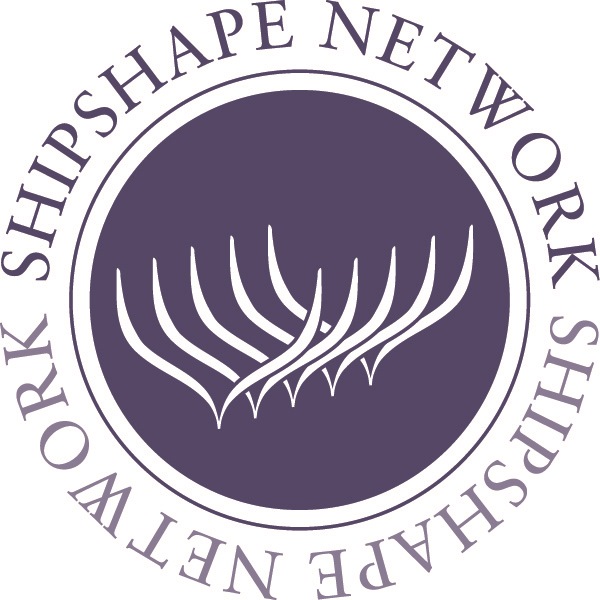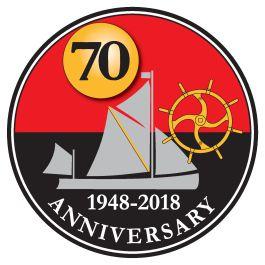Sponsors
National Historic Ships UK acknowledges the financial support of its sponsors


The Thames Sailing Barge Trust (TSBT)
The Thames Sailing Barge Trust (TSBT) is a registered charity that exists to preserve two Thames barges in sailing condition and was formed in 1948.
The Trust aims to improve the understanding of the public as to the historic and cultural role of Thames Sailing Barges in the heritage of Great Britain and to promote and teach the practice and the traditions and skills of seamanship involved in the handling and maintaining of these craft by taking people sailing in the waters traditionally sailed by these craft. www.bargetrust.org
TSBT is a volunteer run, non-profit company and all sailing fees and membership subscriptions are used to maintain and restore the barges and meet their operating expenses.
The TSBT owns two Thames spritsail barges, Centaur and Pudge.
Constructed in 1895, Centaur is one of the surviving operational wooden barges from the well-regarded barge builders
John & Herbert Cann. She was launched at Harwich and took part in the traditional barge races from build.
During her service in the coastal trade, she visited ports of France. Belgium and the Netherlands. She continued trading throughout the First World War, then carrying coke and pitch, before entering the grain trade. From 1933 she joined the Colchester fleet of Francis & Gilders Ltd, which merged with the London and Rochester Trading Company in 1951. Her registration was closed in 1955 and she became an unrigged timber lighter. She was subsequently sold to the Thames Sailing Barge Club (now Trust) who, since 1977, have conserved and reconstructed her over 35 years mainly with volunteer labour. During this time she has continued to race regularly, winning the Inter match Trophy in 1993.
Centaur continues to operate on the East Coast in her original heritage setting and with the same rig as in her cargo-carrying days. The Trust retains the use of rope made from natural fibres such as hemp and sisal and wherever practical, traditional materials and methods are used.
Pudge was built in 1922 by London & Rochester Trading Co. and is a Thames sailing barge with a hull construction of pitch pine on oak with a flush deck, the steering wheel on a ‘short spindle’ without the usual raised cabin top. Originally spritsail rigged with bowsprit an auxiliary oil engine made by The Bergius Co. Ltd of Glasgow was installed in 1932.
Pudge is one of the last wooden barges to be built, (although further barges were built of steel).
The Conservation Project
A survey found that conservation work was required on Centaur, the first major conservation the historic vessel had undergone since 1995. She was constructed with two layers of bottom planking: a two inch inner layer and a one inch sacrificial outer layer, which protects the inner layer of the hull.
Following 118 years of working, the sacrificial planking fore and aft were wearing thin and needed replacing. The inner two inches (which are the vessel's original bottom from 1895) were sound, except for one or two timbers at the stern which were replaced in elm, as per her original planking.
The sacrificial layer were replaced in hardwoods Opeipi and Iroko, taking around 20 weeks to complete.
Heritage Lottery Fund (HLF)
In August 2013 the TSBT confirmed funding of £100,000 from HLF enabling the work to be undertaken.
Roger Newlyn, Trustee and Chair of the TSBT said: “We’re delighted that the Heritage Lottery Fund has given us this grant. Centaur carried bulk cargoes on the Thames Estuary and the rivers of Essex, Suffolk and Kent for over sixty years and these days she is central to the Trust’s aims of passing on to the next generation the traditions of sailing and maintaining these iconic East Coast vessels.”
Developing skills
The project allows the Trust to work with a number of outside organisations that already provide training for working on wooden vessels.
Tom Browning, an apprentice from the Faversham Creek Trust, worked on Centaur. He achieved his Level 2 apprenticeship with Simon Grillet, during the Cambria restoration at Standard Quay in 2011. He undertook his Level 3 training through this work experience.
The reconstruction work was carried out at Oare, Faversham, under the management of shipwright Tim Goldsack.
The Trust also uses Centaur as a means of training volunteers to be skippers and mates, ensuring the future of the vessel's sailing activity.
Better condition
When the sacrificial bottom planking was replaced, Centaur was able to obtain a new 5 year MCA certificate. Given her condition generally this means it will be at least 10 years before any further major conservation work will be required.
The best way of maintaining Centaur is to sail her regularly, which also generates income. Without this work, the barge will lose funding for ongoing conservation, potentially causing her to become static and derelict.
Learning about heritage
A new education programme working with sea cadets, schools and special need groups will be facilitated by this project, helping to engage a wide reach of people with maritime heritage.
The Trust aims to include sailing days for special needs groups, sea cadets and school children.
Find out about the Thames Sailing Barge Trust's Pudge Project here (news item below).
Latest News
June 2021 - The Pudge Project Update
Over the last couple of months, work on Pudge has continued at Fullbridge. The new forehorse and main horse have been completed and are now on Pudge awaiting to be fitted once other work is completed. They have had two coats of oil and will still require at least three further coats in due course.
Work has also been completed on the forehatch boards and the supporting beams for the main hatch boards have been cut and shaped and put in place, but will not be fixed until we have completed more of the project. Pudge’s original fore and afters have also been stripped of paint and retained.
The bracing knees for the windlass bitts are still to be put in place and the windlass fitted. This has been delayed pending some repair work needed for some rotten wood on the rail, which will be hard to repair once the knee is fitted.
An important milestone took place in May: the first part of the project was signed off after the Trust’s surveyor reviewed the work completed by Kevin Finch and his team. As was expected, the surveyor was very pleased with the high standard of work that Kevin and his team had carried out. This important step means that the Trust can start using volunteers to undertake tasks in readiness for phase two of the project, the re-fit, which should start in September.
It was hoped that Pudge would move back to the Quay at the Hythe for the summer, but because the main hatch is still open her winter cover has been kept in place, meaning she cannot be moved from her from her berth at Fullbridge. Unfortunately, there is no public access. Volunteers are only allowed on site with the permission of the Trust and under supervision as access to Pudge is difficult.
Future work on Pudge will include painting the linings with Sadolin and the oiling or staining all new timber, including the inwales coamings and underdeck, so as to bring out the natural wood. The carlings have already had one coat of primer, but we aim, under the advice of Kevin Finch, to add another and then two coats of undercoat and two coats of top coat.
The Trust have plenty more to do on the Pudge Project and would love volunteers to get involved. If you would be interested in volunteering with the Trust please email: membership@bargetrust.org.
May 2020 Thames Sailing Barge Trust has received £25,200 National Lottery support to help address the impact of Covid-19 pandemic on heritage. Full story here.
May 2019 Thames Sailing Barge Trust receives ‘Permission to Start’ from National Lottery Heritage Fund to secure the future of Dunkirk Little Ship, s.b. “Pudge”
The Thames Sailing Barge Trust which is based in Maldon, Essex has now received “permission to start” from The National Lottery Heritage Fund for the Perpetuation of the Thames Sailing Barge “Pudge” project. The project aims to restore “Pudge” by replacing her decking and hatches, improving her facilities and accommodation, researching and interpreting her heritage and addressing the skills shortage in the Thames sailing barge community.
The Thames Sailing Barge Trust has reached this milestone by managing to raise the remaining funds to cover the costs of the project after being awarded a grant of £328,000 from The National Lottery Heritage Fund.
On Friday 10th May, the Trust will hold a special launch event to celebrate the start of the project which will last for approximately 2 years.
The Rt. Hon. John Whittingdale OBE MP, Member of Parliament for Maldon said: - “I am delighted to learn that the Thames Sailing Barge Trust has, with the help of The National Lottery Heritage Fund, raised enough money to proceed with the restoration of SB Pudge. For many people, the Thames barge is the symbol of Maldon and the Trust does great work in maintaining the two it owns and at the same time helping to keep alive traditional shipbuilding skills”
Brian Dawson, Trustee and Chairman of the Thames Sailing Barge Trust, said:- “As “Pudge”, our veteran Dunkirk Little Ship approaches her 98th birthday it is great news to know that The National Lottery Heritage Fund are supporting the Thames Sailing Barge Trust in our objectives of conserving her for future generations. In addition, it will give us the ability to educate those future generations with the skills to sail and maintain such craft”.
Using local skilled craftsmen, assisted by a team of volunteers and trainees, the project will replace decking, hatches and any weakened structural timbers on “s.b.Pudge” to keep her as a licensed and sailing member of the historic Thames sailing barge fleet for many years to come. In addition, she will be refitted to make her more attractive for people to sail on and to visit her to learn about the heritage embedded in the vessel, her traditions and her trade.
Finding experienced crews to sail “Pudge” and other Thames sailing barges is becoming an increasingly difficult task, as older generation of skippers and mates are retiring. The Trust will embark on a structured training and accreditation programme which will develop the skills and experience of up to ten people a year as third hands with the objective of creating the next generation of mates and skippers.
The Trust will also work with the local museums to collaborate on temporary displays interpreting the history of Thames barges, co-created with local media students. By working with schools and youth agencies, the Trust aims to change attitudes towards maritime heritage and improve people’s understanding of it, by considering a career or volunteer role in sailing heritage vessels. The Trust will also enhance its volunteer recruitment programme, to ensure it has the resources to maintain “s.b.Pudge” and have people able to impart information to the public about the barge on their regular open days.

National Historic Ships UK acknowledges the financial support of its sponsors